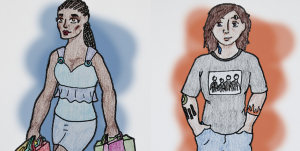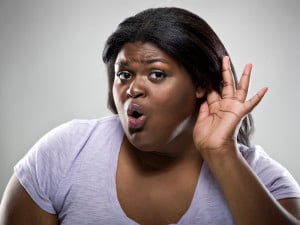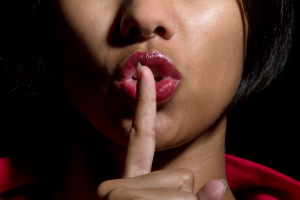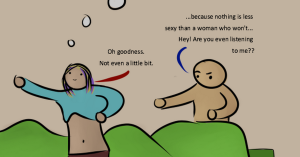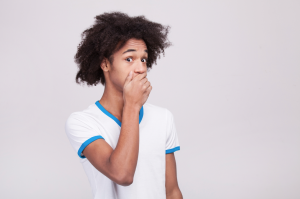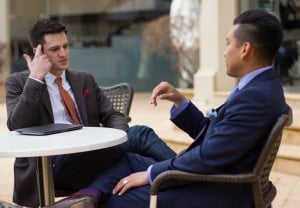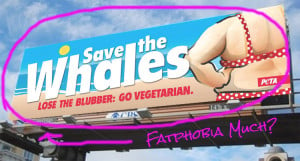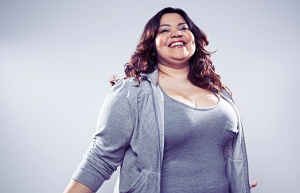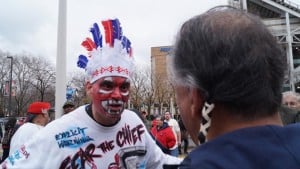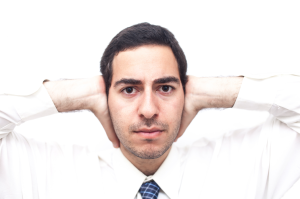I felt the societal pressures of womanhood come on like a plague.
It seemed like one day I was building forts and catching lizards, and the next I was sucking in my gut, picking at my face, and navigating an inescapable shame about my body – a shame that I’ve now spent the last twenty years trying to shirk.
I remember being ten years old and grieving my girlhood – that short period of time when I was allowed to exist without a preoccupation of my physical appearance constantly looming in the front of my mind – a time when my self-esteem wasn’t rooted in whether or not I was pretty enough, skinny enough, busty enough, sexy enough.
Time passed and the more unattainable and oppressive heteronormative femininity felt, the more I grew to hate myself and everybody around me.
In my late teens, I finally gave up. I cobbled together an outfit with layers suitable for all types of weather and didn’t change out of it for an entire year.
I let my leg and armpit hair grow long, and I let the hair on my head spiral into a nest of cords, matts, and tangles (a hairdo I would later ignorantly and appropriatively refer to as dreadlocks).
I ran away from home – started hitchhiking all over the country, going to feminist music festivals, entrenching myself amidst the company of other (mostly white) grrrls who were shirking their feminine hygiene routines (shaving, bathing, hair combing, general beauty maintenance regimens of all types, really) in order to really “stick it to the patriarchy.” (It was a thing, okay?)
We idolized musicians like The Slits, Babes in Toyland, 7 Year Bitch, Ani Difranco, L7, and Switchblade Symphony – all feminists who wrote songs about smashing mainstream beauty standards – all bands featuring white women who wore their hair in dreadlocks at some point or another during their musical careers.
What It Was Like Being A White Girl with Dreadlocks
In navigating through a predominantly white, feminist punk subculture, I never gave a second thought to whether wearing my hair in dreadlocks was offensive — at least to any one other than to The Patriarchy.
Having dreadlocks was part of what allowed me to stop obsessing over my appearance.
As long as I had them, the pressure – well for me as a cis gender white woman – to achieve mainstream, heteronormative beauty standards was off the table.
I suppose I felt empowered by this form of rebellious self-exclusion (the alternative being forced exclusion because I simply failed at womanhood).
While I did run into the occasional asshole on the street who called me a “filthy dyke,” my whiteness led people to read me as “quirky” and “alternative”.
I wasn’t followed around by security guards every time I went into a store. I wasn’t hassled by the cops for hanging out with my friends on street corners. I wasn’t hauled off to jail on the presumption that I was a gang member just because of my nonconventional appearance.
To further my point, being a white grrrl with dreadlocks, as well as someone who wore clothing scrappily held together by safety pins, dental fIoss and band patches, I was still considered employable and trustworthy.
Without any regard to personal qualifications, even with an incarceration record and no college education, I was often given responsibilities that put me in positions of authority over my co-workers of color.
Despite my rebellious appearance, I enjoyed a level of tolerance from authority figures and society at large that can only be attributed to my whiteness.
Everything changed when I stopped traveling, started investing in local activist projects, and began building a broader, more multiracial community.
For the first time, my peers had lots of questions and critiques about my choice to wear dreadlocks.
The responses other activists had to my hair ranged from mild irritation to downright anger.
People were constantly making comments under their breath when they passed me about “cultural appropriation” – I had no idea what that meant.
Some friends eventually suggested some readings and resources that would help me understand.
I read them and learned more about the history and symbolism of dreadlocks in the US in context to black folk’s resistance movements against white supremacy. I learned that black folks in the US with dreadlocks are not seen as “quirky” or “alternative,” but as “dangerous” and “militant”.
I learned to identify the ways that white colonist mentalities show up in our contemporary, everyday lives.
I realized that I was participating in the shitty reality that, for centuries, white people have felt entitled to taking pretty much anything their hearts desire – entire continents, human bodies, land resources, and, yes, whatever cultural trappings of the communities they colonized that were thought to be intriguing at the time.
The Harmful Messages I Was Sending to the World as a White Woman with Dreadlocks
It finally became clear to me that by wearing my hair in dreadlocks as a white person, the nonverbal statements I was making to folks of color were:
“Look! I can reject all of mainstream society’s expectations of me and still be treated with more respect than you!”
“Your legacies of cultural resistance are so irrelevant that they’ve become nothing more than a fashion accessory to help me evade the expectations of white womanhood!”
“I don’t care that my presence illicitness discomfort and sometimes communicates what is seen as blatant disrespect!”
“I don’t care that my hairstyle symbolizes the kind of white entitlement that has resulted in centuries worth of global, colonial violence.”
Etcetera.
I’m pretty embarrassed to say so… but even after this new stage of awareness I stiiiiillllll had a super hard time letting them go.
Some examples of my last stitch arguments were:
1. “Lots of cultures throughout the ages have worn dreadlocks! I’m part Scandinavian! My ancestors were Vikings!”
To which my friends responded:
Yes, it’s true that dreadlocks are worn in all different cultures around the world, but the context for which they are worn in the US is explicitly rooted in black folks’ (Rastafarians specifically) symbolic resistance to white supremacy.
When white people in the US wear dreadlocks, the power of this symbolic resistance is reduced to an “exotic” fashion trend wherein the oppressor is able to “play,” temporarily, an “exotic other” without acknowledging or experiencing any of the daily discriminations black folks have to face.
2. “We live in an intercultural society. Black women wear white hairstyles, so what’s up with the double standard?”
To which my friends responded:
Black women are told that in order to appear “respectable” in US society, they need to invest an obscene amount of time and energy into making themselves “look more white.”
Due to this fucked-up societal pressure – and due to the institutional power that white people have in determining mainstream beauty standards – it’s not the same.
3. “Nobody can control me! I do what I want!”
To which my friends responded:
…and you know what? You’re white, so it makes complete sense that you’d feel that way.
4. “By wearing dreadlocks, I’m giving up my white privilege to stand in solidarity with POC.”
To which my friends responded:
You are an oppression tourist – a white girl who always has an escape route back to the open arms of white supremacy once she is through rebelling. You can cut them off anytime.
To pretend otherwise or assume yourself a martyr is misguided and offensive.
5. “But there’s a difference between ‘appreciation’ and ‘appropriation’ isn’t there?”
My friends referred me to articles like these, saying:
I’m trying to think of examples of things I respect and how I show that respect. I’m actually struggling to think of a time when I respected something, and decided the best way to show that respect was by taking it. You know how I show respect?
I listen.
I listen hard, I listen deeply, and I listen constantly. I listen to stories, I listen to histories, I listen to learn, and I listen to hear when I’ve misstepped. I listen so I can become a more complete human being.
6. “But that’s not what I mean! What about the purpose they serve me?”
To which my friends responded:
Whether or not you mean to be disrespectful, the statements you are communicating are out of your control. Certain cultural symbols will always have semiotic weight – you wouldn’t wear a swastika pendant just because you thought it was pretty.
The Haircut
I finally cut them off – and when I did, I felt (literally and figuratively) a dozen pounds lighter.
Though I am still pretty “alternative” looking, I’ve learned to stand up against systems of oppression by doing the actual footwork in my daily life. I no longer naively expect my physical appearance (on its own) to do that work for me.
Cutting off my dreadlocks was a form of accountability – an acknowledgment of the ways in which I’ve benefited (and continue to benefit) from legacies of extreme, racialized violence.
Cutting off my dreadlocks didn’t make me an instantly “good white person” or even a trustworthy ally, but it sure as hell dismantled some of the barriers that stood in the way of cultivating deep, meaningful relationships based on mutual respect, trust and solidarity.
As feminists, we do need to continue working hard to dismantle society’s oppressive messages about femininity, but we also need to be thinking about the intersections of race, class, and gender, the ways some of us benefit from the system in which we live, and how we can empower and liberate ourselves without contributing to the oppression of someone else.
[do_widget id=’text-101′]
Annah Anti-Palindrome is a Contributing Writer for Everyday Feminism and a Bay Area-based writer, musician, and queer/femme antagonist who hails from the working-class craters at the base of the Sierra Foothills. For more info on her work, see annahantipalindrome.com. To contact her, you can message her via her Facebook fan page!
Search our 3000+ articles!
Read our articles about:
Our online racial justice training
Used by hundreds of universities, non-profits, and businesses.
Click to learn more






